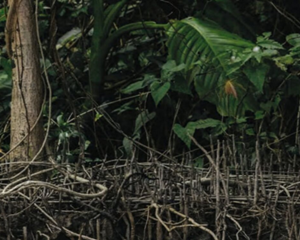But there is something else I've learned about this place, something hidden in Bailique's wild terrain.
但關于這個地方,我還學到了一些別的,是某種隱藏在貝利克荒野中的事物。
Maybe "disguised" is a better word -- for, during my initial expedition in 2022, I was confused at first to see no sign of the foliage that I had expected would crowd the islands' coastlines: mangroves.
或許“偽裝”是比較好的說法,因為我2022年第一次來探勘的時候,起初很困惑,怎么沒有看到預期中應該遍布群島海岸線的植物,也就是紅樹林。
I'm part of an international group of scientists studying the ecological benefits of mangroves, those dense tangles of arching trunks and branches that grow in and alongside warm tidal waters.
我參與的一個國際科學家團體專門研究紅樹林對生態的好處,這種植物的枝干彎曲,彼此緊密交織生長在溫暖的潮間帶水域及周遭。
We use "mangrove" as a group name for certain kinds of trees that require these tropical salty conditions, and in recent years we have learned how desperately the warming planet needs them.
我們用“紅樹林”一詞作為一群需要這種熱帶咸水環境的特定樹種的集合名詞,而我們近年來才了解到,逐漸暖化的地球是多么迫切地需要這類植物。
The trees' woody underwater architecture makes a safe home for the marine life on which fishing societies depend.
這類樹木在水下形成木質結構,是漁業社會賴以為生的海洋生物的安全居所。
On land, the tough root networks help prevent erosion.
在陸地上。強韌的根部網絡有助避免土壤遭到侵蝕。
Mangroves are exceptionally efficient at carbon capture: Within the muddy sediment beneath the roots, they can trap -- keep out of the atmosphere -- up to 10 times as much carbon as other kinds of tropical trees.
紅樹林的碳捕獲效率極高:在根部底下的泥濘沉積物中,它們捕獲的碳是其他熱帶樹種的十倍,讓碳不會跑到大氣中。
But in many places where mangroves have traditionally thrived -- Indonesia and the Philippines, for example -- they are disappearing, cleared out to make way for shrimp farms and other development.
但在許多原本紅樹林蓬勃生長的地方--例如印尼和菲律賓--現在紅樹林都逐漸絕跡,被清空開發成養蝦場或進行其他開發。
Brazil has laws protecting mangrove forests, but to enforce those laws, the government needs to know exactly where the mangroves are, which is why our team (including fellow National Geographic Explorers Margaret Owuor and Thiago Sanna Freire Silva) conducted that first Bailique exploration.
巴西有法律保護紅樹林,但如果要執行這些法律,政府必須先確認哪里有紅樹林,所以我們的團隊(包括同為國家地理探險家的瑪格瑞·奧武和帝亞戈·桑納·佛列拉·席爾瓦)才進行了第一次的貝利克探勘。
We knew nobody had yet formally surveyed the foliage of the river mouth islands.
我們知道還沒有人正式調查過河口群島的植物。
I remember our boat chugging slowly through the different channels of the archipelago, nearing one shore after another, and... No mangroves.
我還記得我們的船噗噗噗地慢慢穿行在群島的各處水道,靠近一處又一處的島岸,結果...沒有紅樹林。

Where were they? We saw tall acai palms, bamboos, and coconut trees.
它們在哪里?我們看到了高聳的阿薩伊棕櫚、竹子和椰子樹。
We started climbing off the boat to investigate, increasingly perplexed.
我們開始下船探索,但是越來越困惑。
Finally, we pushed into one beautiful mess of high jungly overgrowth and looked up and around and BOOM, mangroves -- but growing in a way none of us thought possible.
最后,我們鉆進一片密密交織的美麗高大叢林,環顧四周,然后突然領悟,這就是紅樹林--但生長的方式卻是我們認為根本不可能的。
They were a little distance inland, scattered amid freshwater trees, intertwined with them and sharing their soil.
它們長在稍微內陸一點的地方,生長在淡水樹種之間,也和淡水樹種互相交織并共享土壤。
As a marine ecologist, I promise you: This does not happen. Or so we had thought.
身為海洋生態學家,我可以跟你保證:沒有這種事。又或者只是我們這樣以為。
Amazonia is not like any other place on Earth, and the river mouth is not like any other place in Amazonia.
亞馬遜流域跟地球上其他地方都不一樣,它的河口也跟亞馬遜的其他地方都不一樣。
What we found there may be an ecologically unique kind of forest, with 130-foot mangroves, among the biggest I've ever seen, growing in ground that seems insufficiently salty to sustain them.
我們在那里發現的可能是一種生態上很獨特的森林,那里有130英尺高的紅樹林,是我見過數一數二大的、生長在照理不夠咸、無法維持它們生長的土地上。
Another Bailique astonishment, like the plume. Chico motored us over there so I could show the monster stealth mangroves to Felipe, who was not part of the 2022 team.
這是貝利克的又一個驚奇之處,就像羽流一樣。奇柯開船載我們到那里,好讓我能指給費利佩看看這些龐大的隱形紅樹林,因為他沒有參加2022年的團隊。
It took him a minute, craning his neck upward and squinting, to sort out what he was looking at. "Nossa," he said. Wow.
他花了一分鐘,伸長脖子,瞇著眼睛,弄清楚自己到底看到了什么。“Nossa(哇),”他說。
It turns out that unusual stands like these grow all over the archipelago, which means updated maps now include thousands of acres of newly identified mangrove forests eligible for protection.
結果整片群島都有這種不尋常的樹林,這代表更新過的地圖上如今包括了幾百公頃新辨識出、合乎保護資格的紅樹林。
Some of the trees are so big, and probably so old, that the soils trapped beneath them may be profoundly deep carbon sinks, "an unprecedented value to climate mitigation," we wrote in the first science paper published after that initial visit.
有些樹實在太大,可能也已經很老了,所以底下抓住的土壤可能是很深很深的碳匯,“對減緩氣候變化的價值前所未有。”我們在首度造訪后發表的第一篇科學報告中寫道。
Encouraging news, so far.
到目前為止,這是鼓舞人心的消息。
And Felipe and I are discovering that people here don't realize they live amid mangroves.
費利佩和我后來發現,這里的人根本不知道自己就住在紅樹林里面。
They have their own names for the trees our team recognized; those beneficial mangroves they hear about are the distant thickets up and down the Atlantic coastline, they say.
我們團隊辨識出來的這些樹木,他們有自己取的名字;他們說,我們說的那種很多好處的紅樹林離他們很遠,是沿大西洋海岸線分布的灌叢。
When we ask a survey question about how they use nature, and we mention mangroves, their response is always the same: "We don't have those here."
當我們在調查中詢問他們如何利用大自然時,如果提到紅樹林,他們的反應都一樣:“我們這里沒有那種樹。”



